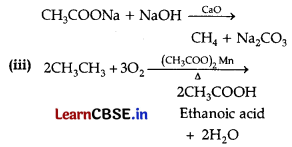Students must start practicing the questions from CBSE Sample Papers for Class 11 Chemistry with Solutions Set 3 are designed as per the revised syllabus.
CBSE Sample Papers for Class 11 Chemistry Set 3 with Solutions
Time Allowed : 3 hours
Maximum Marks: 70
General Instructions:
- There are 33 questions in this question paper with internal choice.
- Section – A consists of 16 multiple -choice questions carrying 1 mark each.
- Section – B consists of 5 short answer questions carrying 2 marks each.
- Section – C consists of 7 short answer questions carrying 3 marks each.
- Section – D consists of 2 case – based questions carrying 4 marks each.
- Section – E consists of 3 long answer questions carrying 5 marks each.
- All questions are compulsory.
- Use of log tables and calculators is not allowed.
Section-A
The following questions are multiple-choice questions with one correct answer. Each question carries 1 mark. There is no internal choice in this section.
Question 1.
What will be the molality of the solution containing 18.25 g of HC1 gas in 500 g of water?
(A) 0.1 m
(B) 1 M
(C) 0.5 m
(D) 1 m
Answer:
(A) 0.1 m
Explanation: Mass of HC1 = 18.25 g Mass of solvent (water) = 500 g = 0.5 kg
Molecular mass of HC1 = 1 + 35.5 = 36.5
Number of moles of HC1 = \(\frac{18.25}{36.5}\) = 0.5
Molality m = \(\frac{0.5}{0.5}\) = 1 m
Question 2.
One mole of any substance contains 6.022 × 10
23
atoms/molecules. Number of molecules of H
2
SO
4
present in 100 mL of 0.02 M H
2
S0
4
solution is…….
(A) 12.044 × 10
20
molecules
(B) 6.022 × 1023 molecules
(C) 1 × 1023 molecules
(D) 12.044 × 1023 molecules
Answer:
(A) 12.044 × 10
20
molecules
Explanation:
Number of moles of H
2
SO
4
= molarity × volume in mL
= 0.02 × 100
= 2 milli moles
= 2 × 10
-3
mol
Number of molecules of H
2
SO
4
= Number of moles × N
A
= 2 × 10
-3
× 6.022 × 10
23
= 12.044 × 10
20
molecules
![]()
Question 3.
Which of the following statements about the electron is incorrect?
(A) It is a negatively charged particle
(B) The mass of electron is equal to the mass of neutron.
(C) It is a basic constituent of all atoms.
(D) It is a constituent of cathode rays.
Answer:
(B) The mass of electron is equal to the mass of neutron.
Explanation:
The mass of electron is very small in comparison to the mass of neutron.
Question 4.
Which of the following is not an actinoid?
(A) Curium (Z = 96)
(B) Californium (Z= 98)
(C) Uranium (Z = 92)
(D) Terbium (Z = 65)
Answer:
(D) Terbium (Z = 65)
Question 5.
PC1
5
, PCl
3
and Cl
2
are at equilibrium at 500 K in a closed container and their concentrations are 0.8 × 10
-3
mol L
-1
1.2 × 10
-3
mol L
-1
and 1.2 × 10
-3
mol L
-1
respectively. The value of Kc for the reaction PCl
5
(g) ⇌ PCl
3
(g) + Cl
2
(g) will be
(A) 1.8 × 10
3
mol L
-1
(B) 1.8 × 10
-3
(C) 1.8 × 10
-3
L mol
-1
(D) 0.55 × 10
4
Answer:
(B) 1.8 × 10
-3
K
c
= \(\frac{\left[\mathrm{PCl}_3\right]\left[\mathrm{Cl}_2\right]}{\left[\mathrm{PCl}_5\right]}=\frac{1.2 \times 10^{-3} \times 1.2 \times 10^{-3}}{0.8 \times 10^{-3}}\)= 1.8 × 10
-1
Question 6.
When hydrochloric acid is added to cobalt nitrate solution at room temperature, the following reaction takes place and the reaction mixture becomes blue. On cooling the mixture it becomes pink. On the basis of this information mark the correct answer.
![]()
(A) ∆H > 0 for the reaction.
(B) ∆H < 0 for the reaction. (C) ∆H = 0 for the reaction. (D) The sign of AH cannot be predicted on the basis of this information.
Answer:
(A) ∆H > 0 for the reaction.
![]()
Question 7.
The exhibition of various oxidation states by an element is also related to the outer orbital electronic configuration of its atom. Atom(s) having which of the following outermost electronic configurations will exhibit more than one oxidation state in its compounds.
(A) 3s
1
(B) 3d
1
4s
4
(C) 3d
2
4s
2
(D) ls
1
2p
2
Answer:
(C) 3d
2
4s
2
Explanation:
Elements with outer electronic configuration as 3s
1
, 3d
1
4s
2
and ls12p2does not exhibit oxidation number of more than one as they can only loose one electron present in outermost shell.
Question 8.
Using the standard electrode potential, find out the pair between which redox reaction is not feasible.
E
θ
values : Fe
3+
/Fe
2+
= +0.77; I
2
/I
–
= +0.54:
Cu
2+
/Cu = +0.34: Ag
+
/Ag = +0.80 V
(A) Fe
3+
and I
–
(B) Ag
+
and Cu
(C) Fe
3+
and Cu
(D) Ag and Fe
3+
Answer:
(D) Ag and Fe
3+
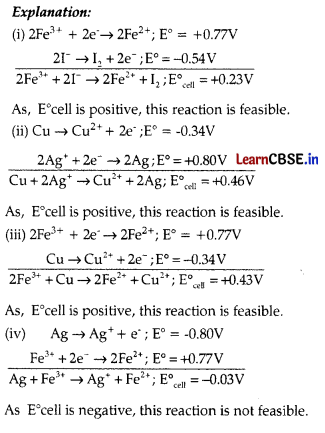
Question 9.
Which of the following is the correct IUPAC name?
(A) 3-Ethyl-4,4-dimethylheptane
(B) 4,4-Dimethyl-3-ethylheptane
(C) 5-Ethyl-4,4-dimethylheptane
(D) 4,4-Bis(methyl)-3-ethylheptane
Answer:
(A) 3-Ethyl-4,4-dimethylheptane
Explanation:
Because, while writing IUPAC name, the alkyl groups are written in alphabetical order. Thus, lower locant 3 is assigned to ethyl. Prefix, di, tri, and tetra are not included in alphabetical order.
Question 10.
In which of the following, functional group isomerism is not possible?
(A) Alcohols
(B) Aldehydes
(C) Alkyl halides
(D) Cyanides
Answer:
(C) Alkyl halides
Explanation:
Alkyl halides do not show functional isomerism. Alcohols and ethers, aldehydes and ketones, cyanides and isocyanides are functional isomers.
Question 11.
Arrange the following in decreasing order of their boiling points.
(a) n-butane
(b) 2-methylbutane
(c) n-pentane
(d) 2, 2-dimethylpropane
(A) a > b > c > d
(B) b > c > d > a
(C) d > c > b > a
(D) c > b > d > a
Answer:
(D) c > b > d > a
Explanation:
As the number of carbon atom increases, boiling point increases. Boiling point decreases with branching.
Question 12.
The correct IUPAC name of the following alkane is

(A) 3,6-Dimethyl-2-methylheptane
(B) 5-Isopropyl-3-ethyloctane
(C) 3-Ethyl-5-isopropyloctane
(D) 3-Isopropyl-6-ethyloctane
Answer:
(A) 3,6-Dimethyl-2-methylheptane
![]()
Question 13.
Given below are two statements labelled as Assertion (A) and Reason (R).
Assertion (A): Electron gain enthalpy becomes less negative as we go down a group.
Reason (R): Size of the atom increases on going down the group and the added electron would be farther from the – nucleus.
Select the most appropriate answer from the options given below:
(A) Both A and R are true and R is the correct explanation of A
(B) Both A and R are true but R is not the correct explanation of A.
(C) A is true but R is false.
(D) A is false but R is true.
Answer:
(D) A is false but R is true.
Question 14.
Given below are two statements labelled as Assertion (A) and Reason (R).
Assertion (A): Sodium chloride formed by the action of chlorine gas on sodium metal is a stable compound. Reason (R): This is because sodium and chloride ions acquire octet in sodium chloride formation.
Select the most appropriate answer from the options given below:
(A) Both A and R are true and R is the correct explanation of A
(B) Both A and R are true but R is not the correct explanation of A.
(C) A is true but R is false.
(D) A is false but R is true.
Answer:
(A) Both A and R are true and R is the correct explanation of A
Question 15.
Given below are two statements labelled as Assertion (A) and Reason (R)
Assertion (A): A solution containing a mixture of acetic acid and sodium acetate maintains a constant value of pH on addition of small amounts of acid or alkali.
Reason (R): A solution containing a mixture of acetic acid and sodium acetate acts as a buffer solution around pH 4.75.
Select the most appropriate answer from the options given below:
(A) Both A and R are true and R is the correct explanation of A
(B) Both A and R are true but R is not the correct explanation of A.
(C) A is true but R is false.
(D) A is false but R is true.
Answer:
(A) Both A and R are true and R is the correct explanation of A
Question 16.
Given below are two statements labelled as Assertion (A) and Reason (R)
Assertion (A): Energy of resonance hybrid is equal to the average of energies of all canonical forms.
Reason (R): Resonance hybrid cannot be presented by a single structure.
Select the most appropriate answer from the options given below:
(A) Both A and R are true and R is the correct explanation of A
(B) Both A and R are true but R is not the correct explanation of A.
(C) A is true but R is false.
(D) A is false but R is true.
Answer:
(D) A is false but R is true.
Explanation:
Canonical structures always have more energy than resonance hybrid. Resonance hybrids are always more stable than any of the canonical structures. The delocalization of electrons lowers the orbitals energy and gives stability. left after the reaction gives the amount of acid reacted with ammonia.
Section-B
This section contains 5 questions with internal choice in one question. The following questions are very short answer type and carry 2 marks each.
Question 17.
If ten volumes of dihydrogen gas reacts with 5 volumes of dioxygen gas.
(a) How many volumes of water vapour would be produced?
(b) Name the associated law with this observation.
Answer:
(a) When 2 volumes of dihydrogen react with 1 volume of oxygen, 2 volumes of water is produced:
![]()
Therefore, when 10 volumes of dihydrogen react with 5 volumes of oxygen, 10 volumes of water is produced.
(b) This observation is associated with the Gay Lussac’s law of gaseous volumes. According to this law, the ratio between the volumes of the reactant gases and the products can be expressed in simple whole numbers.
Question 18.
State and explain Hess’s Law of constant heat summation with a suitable example.
Answer:
According to this law, “If a reaction takes place in several steps then its standard reaction enthalpy is the sum of the standard enthalpies of the intermediate reactions into which the overall reaction may be divided at the same temperature.”
∆
r
H = ∆
r
H
1
+ ∆
r
H
2
+ ∆
r
H
3
+ …….. It can be represented as:
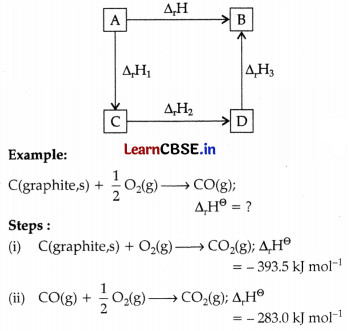
To get one mole of CO(g) on the right, we reverse equation (ii). In this, heat is absorbed instead of being released, so we change sign of ∆
r
H
θ
value.
(iii) CO
2
(g) → CO(g) + \(\frac{1}{2}\)O
2
(g); ∆
r
H
θ
= + 283.0 KJ mol
-1
Adding equation (i) and (iii) to get the desired equation
C(graphite,s) + \(\frac{1}{2}\)O
2
(g) → CO(g)
For which, ∆
r
H
θ
= (- 393.5 + 283.0) = -110.5 kJ mol L
-1
![]()
Question 19.
Account for the following :
(a) A solution of Na
2
CO
3
is alkaline.
(b) Ba(OH)
2
is soluble in water while BaSO
4
is almost insoluble.
Answer:
(a) Na
2
CO
3
+ H
2
0 ⇌ H
2
CO
3
+ 2NaOH
or CO
3
2-
+ 2Na+ + 2H
2
O ⇌ 2NaOH + H
2
CO
3
or CO
3
2-
+ 2H
2
0 ⇌ H
2
CO
3
+ 2OH
–
Since, Na
2
CO
3
produces OH” ions in solution, hence Na
2
CO
3
solution is alkaline is nature.
(b) The lattice enthalpy of BaS04 is much more than its hydration enthalpy and hence it is insoluble in water. But hydration enthalpy of Ba(OH) 2 is much more than lattice enthalpy. Therefore, Ba(OH) 2 is soluble in water.
Question 20.
Calculate the oxidation number of phosphorus in the following species :
(a) HPO
3
2-
(b) PO
4
3-
OR
Split the following redox reactions in the oxidation and reduction half reactions.
(a) 2K(s) + Cl
2
(g) → 2KCl(s)
(b) 2Al(s) + 3Cu
2+
(aq) → 2Al
3+
(aq) + 3 Cu(s)
Answer:
(a) HPO
3
2-
Let, oxidation number of P = x
∴ 1 + x + 3(-2) = -2
1 + x – 6 = -2
x – 5 = -2
x = -2 + 5 = +3
(b) PO
4
3-
Let, oxidation number of P = x
x + 4(-2) = -3
x – 8 = -3
x = -3 + 8
= + 5
OR
(a) K(s) → K
+
(g) + e
–
[× 2] …Oxidation
Cl
2
(g) + 2e
–
→ 2Cl
–
(g) …Reduction
K
+
(g) + Cl
–
(g) → KC1 (s) [ x 2]
2K(s) + Cl
2
(g) → 2KCl (s)…Overall redox reaction (1)
(b) A1(s) → Al
3+
(aq) + 3 e
–
[ x 2] ….Oxidation
Cu
2+
(aq) + 2e
–
→ Cu (s) [ x 3] …Reduction
2A1 (s) + 3Cu
2+
(aq) → 2A1
3+
+ (g) + 3Cu (s) …… Overall redox reaction (1)
Question 21.
Find out the value of Kc for each of the following equilibria from the value of Kp
(a) 2NOC1 (g) ⇌ 2 NO (g) + CI
2
(g), K
p
= 1.8 × 10
-2
at 500 K
(b) CaCO
3
(s) ⇌ CaO (s) + CO
2
(g), K
p
= 167 at 1073 K.
Answer:
(a) ∆n
g
= 3 – 2 = 1,
K
p
× K
c
× (RT)
∆n
or K
c
= \(\frac{\mathrm{K}_p}{\mathrm{RT}}=\frac{1.8 \times 10^{-2}}{0.0831 \times 500}\)(R = 0.0831 bar liter mol
-1
K
-1
= 4.33 × 10
-4
(b) ∆n
g
= 1 – 0 = 1,
K
c
= \frac{\mathrm{K}_p}{\mathrm{RT}}=\frac{167}{0.0831 \times 1073}
= 1.87
Section-C
This section contains 7 questions with internal choice in one question. The following questions are short answer type and carry 3 marks each. (No internal choice given in Board SQP)
Question 22.
Calculate the molar mass of the following compounds:
(i) H
2
O
(ii) C0
2
(iii) CH
4
Answer:
(i) Molar mass of H
2
0
= (2 × atomic mass of hydrogen) + (1 × atomic mass of oxygen)
= 2(1.008u) + l(16.00u) = 18.02u
(ii) Molar mass of CO
2
= 1 × atomic mass of carbon + 2 × atomic mass of oxygen
= 12.011u + 4(1.008 u) = 16.043u
![]()
Question 23.
(i) An atomic orbital has n = 2. What are the possible values of l and m/?
(ii) List the quantum numbers (m, and Z) of electrons for 3d orbital.
(iii) Which of the following orbitals are possible? 2d, Is, 2p and 3f
Answer:
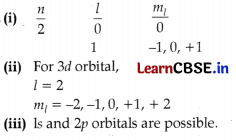
Question 24.
(a) Distinguish between bonding and anti-bonding molecular orbital.
(b) Write the molecular orbital electronic configuration of N2 molecule. Calculate its bond order and predict its magnetic behaviour.
Answer:
| Bonding molecular orbital | Antibonding molecular orbital |
| Its energy is less than that of parent atomic orbitals. | Its energy is greater than that of parent atomic orbitals. |
| It is more stable than the parent atomic orbitals. | It is less stable than the parent atomic orbitals. |
| In bonding molecular orbitals, the probability of finding electrons is maximum. | In anti-bonding mo-lecular orbital, the probability of finding electrons is minimum. |
| It contributes towards the shape of molecule. | It does not contribute towards the shape of molecule. |
(b) Molecular orbital configuration of N
2
:
(σls)
2
(σ*ls)
2
(σ2s)
2
(σ*2s)
2
(π2p
x
)
2
= (σ2p
x
z)
2
Bond order = \(\frac{1}{2}\) (N
b
– N
a
)
= \(\frac{1}{2}\)(10 – 4) = 3.
Magnetic behaviour – Diamagnetic due to absence of unpaired electrons. (14)
![]()
Question 25.
At 60°C, dinitrogen tetroxide is 50% dissociated. Calculate the standard free energy change at this temperature and at one atmosphere.
Answer:
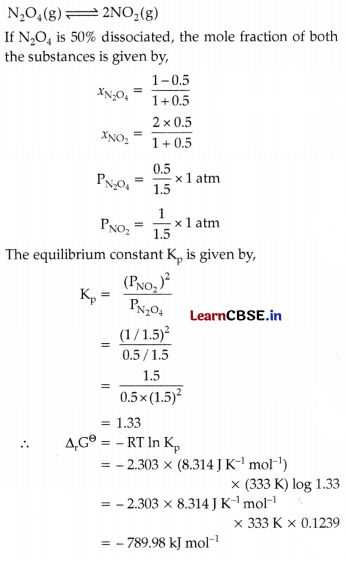
Question 26.
Structures of molecules of two compound are given below:
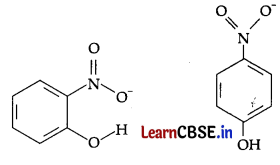
(a) Which of the two compounds will have intermolecular hydrogen bonding and which compound is expected to show intramolecular hydrogen bonding?
(b) The melting point of a compound depends on, among other things, the extent of hydrogen bonding. On this basis, explain which of the above two compounds will show higher melting point.
(c) Solubility of compounds in water depends on power to form hydrogen bonds with water. Which of the above compounds will form hydrogen bond with water easily and be more soluble in it?
Answer:
(a) Compound (II) will have intermolecular hydrogen bonding, because -NO
2
and -OH groups are attached at 1, 4 positions. So, two molecules of compound (II), i.e., p-nitrophenol are joined by intermolecular hydrogen bonding.
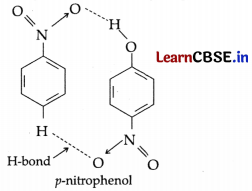
Compound (I) will have intramolecular hydrogen bonding because -N02 and -OH groups are attached at 1, 2 positions. So, H-bonding takes place in same molecule, i.e., o-nitrophenol.
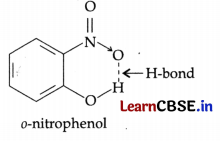
(b) Compound (II) will show higher melting point because large number of molecules are joined together by intermolecular hydrogen bonding.
(c) Compound (II) will form hydrogen bond with water easily so, it is more soluble in water. However, compound (I) exhibits intra-molecular hydrogen bonding so it is not able to form H-bond with water and it is less soluble in water.
Question 27.
Write a short note on Resonance effect.
Answer:
Resonance effect can be defined as the polarity produced in the molecule by the interaction of two pi bonds or between a pi bond and lone pair of electron present on an adjacent atom.
There are two types of resonance effect:
(i) Positive resonance effect:
In this effect, the transfer of electrons is away from an atom or substituent group attached to the conjugated system. The atoms or groups which show +R effect are halogens, -OH, -OR, -NHj, etc.
(ii) Negative resonance effect:
In this effect, the transfer of electrons is towards the atom or substituent group attached to the conjugated system. The atoms or groups which show -R effect are -COOH, -CHO, -CN, etc. (3)
![]()
Question 28.
Draw Newman and Sawhorse projections for the eclipsed and staggered conformations of ethane. Which of these conformations is more stable and why?
Answer:
In staggered form of ethane, the electron clouds of carbon-hydrogen bonds are as far apart as possible. Thus, there are minimum repulsive forces, minimum energy and maximum stability of the molecule. On the other hand, when the staggered form changes into the eclipsed form, the electron clouds of the carbon-hydrogen bonds come closer to each other resulting in increase in electron cloud repulsions. To check the increased repulsive forces, molecule will have to possess more energy and thus has lesser stability.
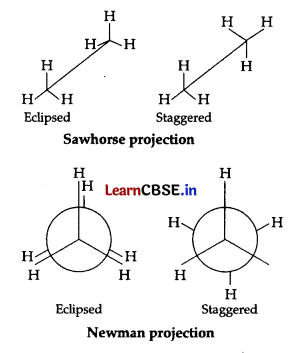
Section-D
The following questions are case based questions. Each question has an internal choice and carries 4 (1 + 1 + 2) marks each. Read the passage carefully and answer the questions that follow.
Question 29.
Read the following passage and answer the following questions:
Due to the stronger attraction of the electrons to the nucleus in these species, the cation with the greater positive charge will have a smaller radius. The anion with the higher negative charge will, however, have a bigger radius. In general, as you move from left to right, the atomic radii decrease as the atomic number rises. The atomic radii, for instance, fall from Li to Ne in the second period. As the effective nuclear charge reduces with increasing atomic number, the atomic radii of elements in a group rise from top to bottom. The size of the atom, which is determined by the distance between the electron and the nucleus, also affects the ionisation enthalpy. As atomic size increases, it gets smaller.
(a) Which is largest in size Cu
+
, Cu
2+
or Cu and why?
OR
Arrange O
2-
, O
–
, O in decreasing radius (size).
(b) What is more metallic, magnesium or aluminium, and why?
(c) Give reasons for the following: ,
(i) The nitrogen ionisation enthalpy is higher than the oxygen ionisation enthalpy.
(ii) The anionic radii are larger than cationic radii.
Answer:
(a) Among Cu
+
, Cu
2+
or Cu, Cu is largest in size due to less effective nuclear charge.
Cu No. of protons = 29,
No. of electrons = 29
Cu
+
No. of protons = 29,
No. of electrons 29 – 1 = 28
Cu2
+
No. of protons = 29,
No. of electrons 29 – 2 = 27
OR
Radius of anion > atomic radius Greater the charge on anion, greater will be the size of anion. ,
Relative order of radius (size):
O
2
> O
–
> O
(b) Due of its low ionisation energy, magnesium is more metallic than aluminium. (1)
(c) (i) 7N – Is
2
2s
2
2p
x
1
2p
y
1
2p
z
-1
Whereas 😯 = Is
2
,2s
2
,2p
x
2
,2p
y
1
and 2p
z
sup>1 Since nitrogen has half filled p-orbital which are more stable than incompletely filled p-orbitals of oxygen. So, ionization enthalpy, of nitrogen is more than that of oxygen.
(ii) By adding more electrons, an a-nion is formed, and as a result, the nuclear charge on the valence shell’s net value lowers. So, the anion’s radius is larger than the parent atom’s. When a cation is formed, its valence shell is removed, and as the number of shells decreases, the radius of the cation decrease.
Question 30.
Read the following passage and answer the following questions:
The branch of science dealing with the relations between energy, heat, work and accompanying changes in the nature and behaviour of various substances around us is called thermodynamics. The main aim of the study of chemical thermodynamics is to learn (i) transformation The branch of science dealing with the relations between energy, heat, work and accompanying changes in the nature and behaviour of various substances around us is called thermodynamics. The main aim of the study of chemical thermodynamics is to learn (i) transformation of energy from one form into another form, (ii) utilization of various forms of energy and (iii) changes in the properties of systems produced by chemical or physical effects. Laws of thermodynamics apply only when a system is in equilibrium or moves from one equilibrium state to another equilibrium state. Macroscopic properties like pressure and temperature do not change with time for a system in equilibrium state.
(a) Give mathematical equation for first law of thermodynamics.
(b) What do you understand by intensive and extensive property in thermodynamics?
(c) What happens when a system undergoes an isothermal change and an adiabatic change?
OR
Derive the relationship C
p
– C
v
= R.
Answer:
(a) E = q + w
(b) An extensive property is a property whose value depends on the quantity or size of matter present in the system, e.g., mass, volume, internal energy, enthalpy, heat capacity, etc. An intensive property is a property which is independent of the mass or quantity or size of matter present in the system e.g., temperature, density, pressure, etc.
(c) When a system undergoes isothermal change, ∆U = 0
i.e., there is no increase or decrease in the internal energy of the system (∆U = 0) then first law reduces to:
0 = q + W
or
q = – W
When a system undergoes adiabatic change q = 0
i.e., there is no exchange of heat between system and surrounding, the first law reduces to :
∆U = W
ad
The work is done at the expense of internal energy. (2)
OR
If q is the amount of heat involved in a system Then, at constant volume,
q – q
v
C
v
∆T = ∆U …..(i)
and at constant pressure.
q = q
p
= C
p
∆T = ∆H ……(ii)
For one mole of an ideal gas (n = 1).
Change in enthalpy
∆H = ∆U + A(pV)
= ∆U + ∆(RT) [when n = 1]
∆H = ∆U + RAT …(iii)
On substituting the values of AH and AU in equation (iii) from equation (i) and (ii),
C
p
∆T = C
v
∆T + R∆T
or
C
p
= C
p
+ R
or
C
p
–
v
= R ……(iv)
Section-E
The following questions are long answer type and carry 5 marks each. All questions have an internal choice.
Question 31.
Attempt any five of the following:
(a) Why 3° carbocation are more stable than 1° carbocation ?
(b) Compare inductive and electromeric effects. ‘
(c) Why CCl
3
COOH is a stronger acid than (CH
3
)
3
CCOOH?
(d) Define the term nucleophile.
(e) Draw the resonance structure of aniline, using curved arrow for electronic movements.
(f) Alcohols are weaker acids than water. Why?
(g) Can we separate two liquids A (boiling point 353 K) and B (boiling point 365 K) present in a mixture by simple distillation?
Answer:
(a) Tertiary carbocation has three electron repelling alkyl groups. This increases +1 effect on carbon and reduces the positive charge making it more stable.
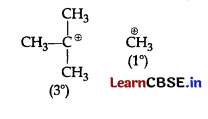
(b) Inductive effect describes the transmission of electrical charges between atoms in a molecule whereas electromeric effect describes the transmission of electron pairs between atoms in a molecule. Inductive effect is affected by electronegativity values of atoms whereas electromeric effect is caused by the number of double bonds and their arrangement.
(c) CCI 3 COOH is a stronger acid than (CH 3 ) 3 CCOOH due to presence of three -I effect causing group (-C1) which increases the acidic strength. Whereas (CH 3 ) 3 COOH contains three +1 effect causing group (-CH 3 ) which decreases the acidic strength. (1)
(d) Nucleophile: A reagent that brings an electron pair to the reactive site is called a nucleophile (Nu:), i.e., nucleus seeking Negatively charged nucleophile-hydroxide (OH – ), cyanide (CN – ), etc.
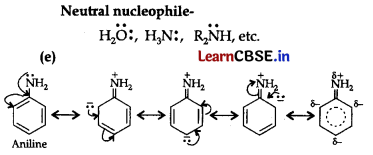
(f) The alkyl group in alcohols has +1 effect due to which electron density increases on oxygen atom which makes the release of hydrogen ion more difficult from alcohol.
R → – O – H
Also, water is a better proton donor. Thus, alcohols are weaker acids than water.
(g) No, because in simple distillation, vapours of both the liquids will be formed simultaneously and will condense together in receiver as the difference between the boiling points is very less. They can be separated by fractional distillation.
![]()
Question 32.
(a) State de Broglie equation.
(b) Write the significance of de Broglie equation.
(c) A beam of helium atoms moves with a velocity of 2.0 × 10
3
ms
-1
. Find the wavelength of the particle constituting the beam, (h = 6.626 × 10
-34
Js)
OR
(i) The electronic energy in Bohr’s orbit is negative. How will you account for it?
(ii) The ionization energy of hydrogen atom is 13.6 eV. What will be the energy of the first orbit of He
+
and Li
2+
ions?
Answer:
(a) de Broglie equation: de Broglie suggested that the wavelength (X) associated with a particle of mass m, moving with velocity v can be given as-
λ = \(\frac{h}{m v}=\frac{h}{p}\)
where
h = Planck’s constant (6.626 × 10
-34
J s)
p = momentum of the particle
(b) Significance of de Broglie equation :
This equation is significant for microscopic objects only. This is because the wavelength associated with ordinary objects are .so small due to their large masses that their wave properties cannot be detected. Wavelength associated with electrons and other sub-atomic particles can be detected experimentally. (1)
(c) Mass of helium = 4 × mass of proton
= 4 × 1.67 × 10
-27
= 6.68 × 10
-27
kg
v = 2.0 x 10
3
m/s
According to de Broglie equation,
λ = \(\frac{h}{m v}\)
= \(\frac{6.626 \times 10^{-34} \mathrm{Js}}{6.68 \times 10^{-27} \mathrm{~kg} \times 2.0 \times 10^3 \mathrm{~m} / \mathrm{s}}\)
= 0.496 × 10
-10
= 49.6 × 10
-12
m = 49.6 pm
OR
(i) The electronic energy in Bohr’s orbit is negative. This negative sign means that the energy of the electron in the atom is lower than the energy of a free electron at rest. A free electron at rest is an electron that is infinitely far away from the nucleus and is assigned the energy value of zero. As the electron gets close to the nucleus (as n decreases), En becomes larger in absolute value and more and more negative.
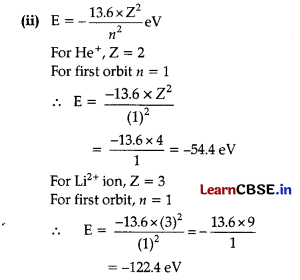
Question 33.
What are the products formed when methane is chlorinated? Explain its mechanism.
OR
(a) Write chemical reactions to illustrate the following:
(i) Kolbe’s reaction
(ii) Wurtz reaction
(b) (i) n-Pentane has higher boiling point than neo-pentane. Why?
(ii) Sodium salt of which acid is needed for the preparation of methane? Write chemical equation involved.
(iii) Complete the following reactions:
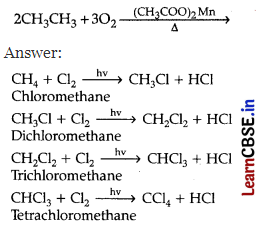
Mechanism:
(i) Initiation:
Homolysis of chlorine molecule in the presence of light or heat. Chain initiation-
![]()
(ii) Propagation: Chlorine free radical attacks the methane molecule and takes the reaction in the forward direction by breaking the C-H bond to generate methyl free radical with the formation of H-Cl.
The methyl radical obtained attacks the second molecule of chlorine to form CH3-C1 with the liberation of another chlorine free radical by homolysis of chlorine molecule.
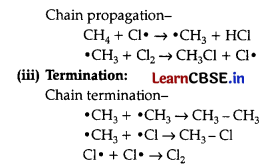
OR
(a) (i) Kolbe’s reaction:
In this reaction, an aqueous solution of sodium or potassium salt of carboxylic acid on electrolysis gives alkane having even number of carbon atoms at the anode.

(ii) Wurtz reaction:
In this reaction, alkyl halides on treatment with sodium in dry ether gives higher alkanes, preferably containing even number of carbon atoms.
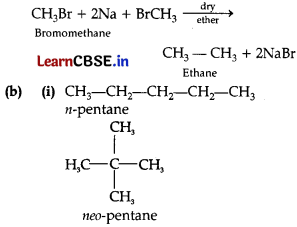
With the increase in number of branched chain, the molecules attain the shape of sphere, thereby decreasing surface area and weak van der Waals forces while large open chain have large surface area. Therefore, pentane has higher boiling point than neo-pentane.
(ii) Sodium salt of acetic acid (sodium acetate) is used for the preparation of methane.
